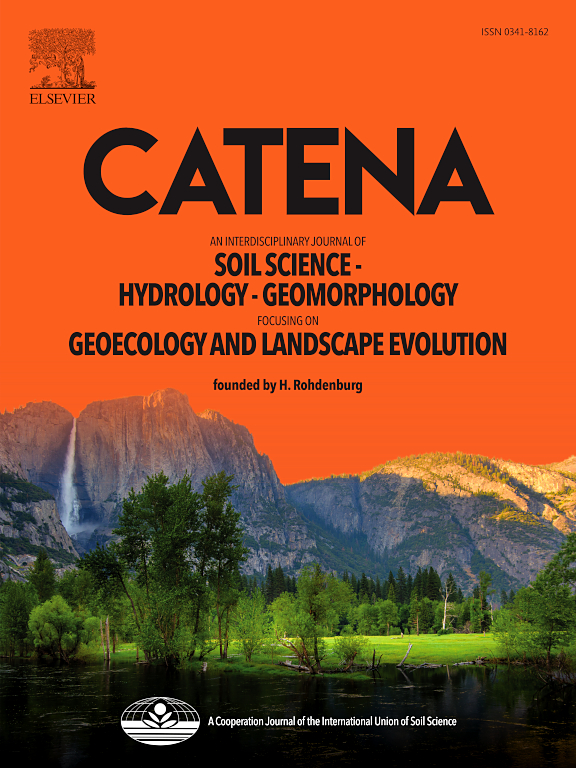Response of soil detachment and erodibility to perennial fibrous-rooted vegetation coverage (Stipa bungeana) on the Loess Plateau
IF 5.4
1区 农林科学
Q1 GEOSCIENCES, MULTIDISCIPLINARY
引用次数: 0
Abstract
Despite the widespread application of revegetation for soil and water conservation, yet the mechanisms and pathways by which vegetation coverage modulates soil detachment (Dr) and erodibility (kr) remain poorly characterized. This study examined 5 distinct vegetation coverages (0 % (cornfield), 15–25 %, 35–45 %, 55–65 %, and 75–85 %) of Stipa bungeana, a typical perennial fibrous-rooted vegetation, across 3 representative sampling sites on the Loess Plateau to quantitatively assess vegetation coverage effects on Dr and kr dynamics. Our results demonstrated that as vegetation coverage increased, soil bulk density decreased; while soil organic matter and root properties (the densities of root volume, length, surface area, and mass) improved. Structural equation modeling revealed that Dr, kr, and critical shear stress (τc) were regulated by synergistic interactions between vegetation roots and soil properties, with vegetation restoration exerting its primary influence through root properties. The kr was more significantly affected by soil properties (path coefficient of −0.53) compared to root properties (path coefficient of −0.45), whereas τc was primarily influenced by root properties. Vegetation restoration effectively reduced Dr under varying water flow intensities, and the influence of root properties on Dr increased with increasing water flow, showing a significant increasing trend in the absolute values of path coefficients (R2 = 0.87, P < 0.05). Notably, site-specific variations in erosion mitigation efficiency were observed under equivalent vegetation coverage levels, highlighting the necessity of incorporating local edaphic factors when optimizing vegetation restoration strategies. Future investigations should encompass a broader spectrum of vegetation functional types across heterogeneous edaphic environments to establish a robust scientific framework for optimizing revegetation protocols.
黄土高原多年生纤维根植被盖度对土壤脱落性和可蚀性的响应
尽管植被恢复在水土保持中得到了广泛的应用,但植被覆盖调节土壤剥离(Dr)和可蚀性(kr)的机制和途径仍不清楚。本研究以黄土高原3个代表性样点为研究对象,研究了典型的多年生纤维根植物刺针草(Stipa bungeana) 5种不同植被覆盖度(0 %(玉米地)、15 - 25%、35 - 45%、55 - 65%和75 - 85%),定量评价了植被覆盖度对Dr和kr动态的影响。结果表明:随着植被盖度的增加,土壤容重减小;土壤有机质和根系性状(根系体积、长度、表面积和质量密度)均有所改善。结构方程模型表明,Dr、kr和临界剪应力τc受植被根系与土壤性质的协同作用调节,植被恢复主要通过根系性质发挥作用。与根系特性(径系数为- 0.45)相比,土壤特性(径系数为- 0.53)对kr的影响更为显著,而τc主要受根系特性的影响。不同水流强度下,植被恢复均能有效降低Dr,根系性状对Dr的影响随水流的增加而增加,路径系数绝对值呈显著增加趋势(R2 = 0.87, P <;0.05)。值得注意的是,在相同的植被覆盖水平下,观察到侵蚀减缓效率的具体地点差异,突出了在优化植被恢复策略时纳入当地土壤因素的必要性。未来的研究应涵盖更广泛的植被功能类型,跨越异质土壤环境,为优化植被方案建立一个强有力的科学框架。
本文章由计算机程序翻译,如有差异,请以英文原文为准。
求助全文
约1分钟内获得全文
求助全文
来源期刊

Catena
环境科学-地球科学综合
CiteScore
10.50
自引率
9.70%
发文量
816
审稿时长
54 days
期刊介绍:
Catena publishes papers describing original field and laboratory investigations and reviews on geoecology and landscape evolution with emphasis on interdisciplinary aspects of soil science, hydrology and geomorphology. It aims to disseminate new knowledge and foster better understanding of the physical environment, of evolutionary sequences that have resulted in past and current landscapes, and of the natural processes that are likely to determine the fate of our terrestrial environment.
Papers within any one of the above topics are welcome provided they are of sufficiently wide interest and relevance.
 求助内容:
求助内容: 应助结果提醒方式:
应助结果提醒方式:


